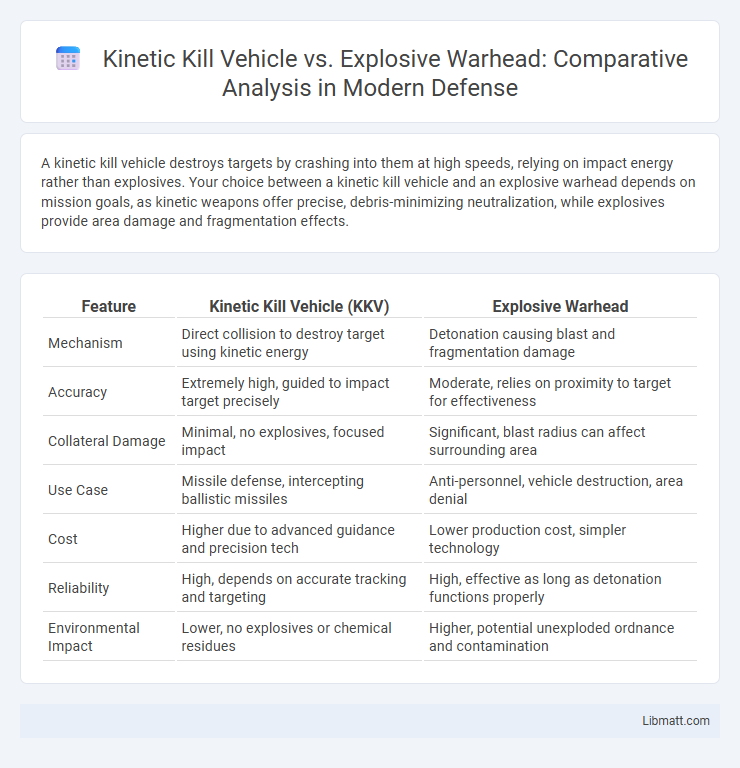A kinetic kill vehicle destroys targets by crashing into them at high speeds, relying on impact energy rather than explosives. Your choice between a kinetic kill vehicle and an explosive warhead depends on mission goals, as kinetic weapons offer precise, debris-minimizing neutralization, while explosives provide area damage and fragmentation effects.
Table of Comparison
| Feature | Kinetic Kill Vehicle (KKV) | Explosive Warhead |
|---|---|---|
| Mechanism | Direct collision to destroy target using kinetic energy | Detonation causing blast and fragmentation damage |
| Accuracy | Extremely high, guided to impact target precisely | Moderate, relies on proximity to target for effectiveness |
| Collateral Damage | Minimal, no explosives, focused impact | Significant, blast radius can affect surrounding area |
| Use Case | Missile defense, intercepting ballistic missiles | Anti-personnel, vehicle destruction, area denial |
| Cost | Higher due to advanced guidance and precision tech | Lower production cost, simpler technology |
| Reliability | High, depends on accurate tracking and targeting | High, effective as long as detonation functions properly |
| Environmental Impact | Lower, no explosives or chemical residues | Higher, potential unexploded ordnance and contamination |
Introduction to Kinetic Kill Vehicles and Explosive Warheads
Kinetic kill vehicles neutralize threats by colliding with targets at high velocity, relying on kinetic energy to destroy missiles or objects without explosives. Explosive warheads use chemical energy to detonate on impact or proximity, causing destruction through blast and fragmentation effects. Kinetic kill vehicles offer precise, clean interception with minimal collateral damage, while explosive warheads provide broader destructive power suited for various combat scenarios.
Defining Kinetic Kill Vehicles: Principles and Operation
Kinetic kill vehicles (KKVs) operate by colliding with targets at extremely high velocities, relying on kinetic energy rather than explosive force to neutralize threats. These precision-guided interceptors use advanced sensors and onboard guidance systems to detect, track, and destroy incoming missiles or objects in space. Unlike explosive warheads, KKVs eliminate the risk of collateral damage from blast effects, making them ideal for missile defense systems focused on direct impact destruction.
Explosive Warheads: Types and Mechanisms
Explosive warheads come in various types, including high-explosive, fragmentation, and shaped charges, each designed to maximize damage through rapid energy release upon detonation. High-explosive warheads generate blast waves to destroy structures, while fragmentation warheads disperse shrapnel to damage targets over a wide area. Shaped charges focus explosive energy into a narrow jet capable of penetrating armor, making them effective against hardened targets.
Historical Development and Deployment
Kinetic kill vehicles (KKVs) emerged during the late 20th century as a precise missile defense technology designed to intercept ballistic missiles through direct collision, eliminating the need for explosive warheads. Early deployment of KKVs occurred in programs like the U.S. Strategic Defense Initiative and Patriot missile systems, emphasizing accuracy and reduced collateral damage compared to traditional explosive warheads. Your understanding of missile defense evolution highlights how KKVs prioritize kinetic energy to neutralize threats, marking a significant shift from conventional explosive payloads in interception strategies.
Modes of Destruction: Kinetic Impact vs Explosive Force
Kinetic kill vehicles destroy targets through direct collision at extremely high velocities, relying on the immense kinetic energy to neutralize threats without explosives. Explosive warheads generate destructive shockwaves and fragmentation to damage or destroy targets through chemical energy release. Your choice between these modes depends on the mission's precision requirements and the surrounding environment's sensitivity.
Target Engagement and Accuracy
Kinetic kill vehicles rely on precise targeting and high-speed intercepts to physically collide with their target, achieving destruction through sheer impact rather than explosive force. Their accuracy depends on advanced sensor systems and real-time guidance to adjust trajectory during engagement, minimizing collateral damage. Your defense strategy can benefit from kinetic kill vehicles' high precision in neutralizing threats without the risks associated with explosive warheads.
Advantages of Kinetic Kill Vehicles
Kinetic kill vehicles eliminate the risk of explosive detonation, making them safer for interception in space and densely populated areas. They provide precise hit-to-kill capability, reducing collateral damage by physically colliding with the target. Their reliance on kinetic energy rather than explosives ensures high effectiveness against ballistic missiles and maneuvering targets.
Benefits and Limitations of Explosive Warheads
Explosive warheads provide the advantage of creating a blast radius and fragmentation, increasing the likelihood of damaging or destroying a target without requiring a direct hit. These warheads are effective against a wide range of threats, including incoming missiles, aircraft, and ground-based targets. Your defense systems benefit from their versatility, but limitations include potential collateral damage and reduced effectiveness against highly maneuverable or hardened targets compared to kinetic kill vehicles.
Real-World Applications and Case Studies
Kinetic kill vehicles are extensively used in missile defense systems such as the U.S. Navy's Aegis Ballistic Missile Defense, where they intercept and destroy incoming threats through direct collision, minimizing collateral damage. Explosive warheads remain prevalent in offensive military operations, demonstrated by their use in precision-guided munitions during conflicts like the Gulf War, allowing for controlled blasts to neutralize targets effectively. You can see real-world effectiveness of kinetic kill technology in the successful interception tests of the Patriot missile system, highlighting its reliability compared to explosive warheads in defensive scenarios.
Future Trends in Warhead Technology
Future trends in warhead technology emphasize increased precision and effectiveness, with kinetic kill vehicles offering enhanced accuracy by relying on direct impact at hypervelocity speeds, eliminating the need for explosive materials. These systems reduce collateral damage and are designed to intercept ballistic missiles more efficiently compared to traditional explosive warheads. Your defense strategy may benefit from integrating kinetic kill vehicles as they evolve with advanced guidance and propulsion systems, promising greater reliability in missile defense.
kinetic kill vehicle vs explosive warhead Infographic

 libmatt.com
libmatt.com